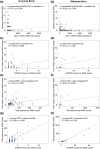Acquisition of Spacers from Foreign Prokaryotic Genomes by CRISPR-Cas Systems in Natural Environments
- PMID: 41229344
- PMCID: PMC12612501
- DOI: 10.1093/gbe/evaf201
Acquisition of Spacers from Foreign Prokaryotic Genomes by CRISPR-Cas Systems in Natural Environments
Abstract
Clustered regularly interspaced short palindromic repeats (CRISPR) and CRISPR-associated (Cas) systems of bacteria and archaea provide immunities against mobile genetic elements, like viruses. In addition, protospacer analyses revealed a very specific acquisition of CRISPR spacers derived from genomes of related species or from closely interacting episymbiont genomes as recently shown for subsurface archaea. However, the origin of most of the spacers that can be found in CRISPR-Cas systems from natural environments has not been deciphered. Here, by analyzing CRISPR-Cas systems of metagenome-assembled genomes (MAGs) from two subsurface environments spanning more than 1 Tb of sequencing data, we show that a substantial proportion of CRISPR spacers are acquired from DNA of other prokaryotes inhabiting the same environment. As such, we found that the number of respective spacers can be up to three times higher than the number of self-targeting spacers. Statistical analyses demonstrated that the acquisition of CRISPR spacers from other prokaryotic genomes is partly explained by the relative abundance of the MAG containing the protospacer, as well as by other factors, such as the total number of CRISPR arrays present in a MAG with the respective spacers. Further, we found that spacer acquisition from foreign prokaryotic DNA occurs in almost all types of CRISPR-Cas systems, but shows preferences for subtypes of CRISPR-Cas systems that differ across the investigated ecosystems. Taken together, our results shed new light on the diversity of CRISPR spacers in natural microbial communities and provide an explanation for some of the many unmatched spacers in public databases.
Keywords: CRISPR spacer; metagenomics; population genomics; protospacer.
© The Author(s) 2025. Published by Oxford University Press on behalf of Society for Molecular Biology and Evolution.
Conflict of interest statement
Conflict of Interest: The authors declare no conflict of interest.
Figures



References
MeSH terms
Substances
LinkOut - more resources
Full Text Sources
Research Materials

